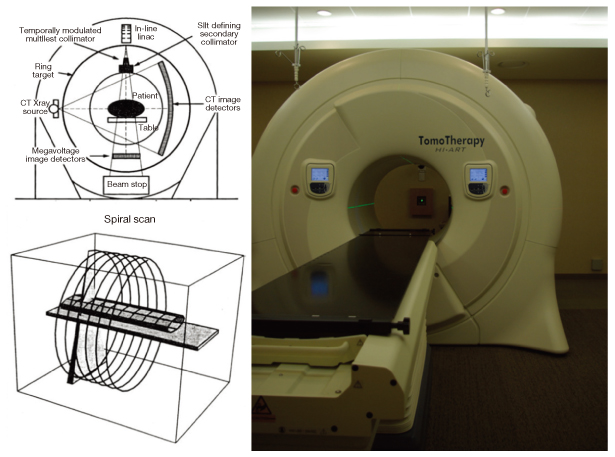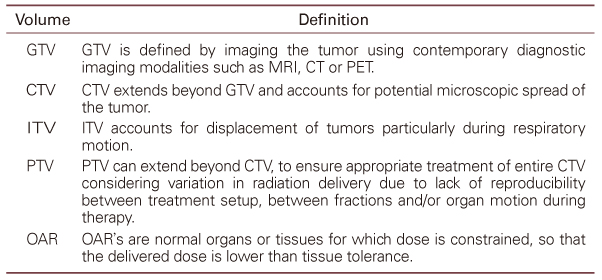 |
 |
- Search
| J Korean Med Assoc > Volume 54(11); 2011 > Article |
Abstract
The role of radiation therapy (RT) in cancer management has grown remarkably during the past few decades. For successful RT, the most important factor is highly conformal radiation delivery focused to the tumor-bearing region while minimizing the surrounding normal tissue damage. RT has evolved from 2-dimensional and 3-dimensional techniques to intensity modulated RT (IMRT) along with the development of computer science and mechanical engineering. IMRT is a special form of 3-dimensional conformal RT techniques, by which the intensities of radiation coming though the beamlets are modulated so that conformal radiation dose distribution around the tumor-bearing region is achieved. IMRT has been covered by the Korean health insurance system since July 2001. The basic principles and process of IMRT are introduced.
References
1. Mackie TR. Radiation therapy treatment optimization. Introduction. Semin Radiat Oncol 1999;9:1-3.
2. Purdy JA. Advances in three-dimensional treatment planning and conformal dose delivery. Semin Oncol 1997;24:655-671.
3. Shepard DM, Olivera GH, Reckwerdt PJ, Mackie TR. Iterative approaches to dose optimization in tomotherapy. Phys Med Biol 2000;45:69-90.
4. Bedford JL, Warrington AP. Commissioning of volumetric modulated arc therapy (VMAT). Int J Radiat Oncol Biol Phys 2009;73:537-545.
5. Mackie TR, Holmes T, Swerdloff S, Reckwerdt P, Deasy JO, Yang J, Paliwal B, Kinsella T. Tomotherapy: a new concept for the delivery of dynamic conformal radiotherapy. Med Phys 1993;20:1709-1719.
6. Palma DA, Verbakel WF, Otto K, Senan S. New developments in arc radiation therapy: a review. Cancer Treat Rev 2010;36:393-399.
7. Lu W, Olivera GH, Chen Q, Chen ML, Ruchala KJ. Automatic re-contouring in 4D radiotherapy. Phys Med Biol 2006;51:1077-1099.
8. Nutting CM, Convery DJ, Cosgrove VP, Rowbottom C, Padhani AR, Webb S, Dearnaley DP. Reduction of small and large bowel irradiation using an optimized intensity-modulated pelvic radiotherapy technique in patients with prostate cancer. Int J Radiat Oncol Biol Phys 2000;48:649-656.
9. Sanguineti G, Cavey ML, Endres EJ, Brandon GG, Bayouth JE. Is IMRT needed to spare the rectum when pelvic lymph nodes are part of the initial treatment volume for prostate cancer? Int J Radiat Oncol Biol Phys 2006;64:151-160.
10. Mangar SA, Huddart RA, Parker CC, Dearnaley DP, Khoo VS, Horwich A. Technological advances in radiotherapy for the treatment of localised prostate cancer. Eur J Cancer 2005;41:908-921.
11. Luxton G, Hancock SL, Boyer AL. Dosimetry and radiobiologic model comparison of IMRT and 3D conformal radiotherapy in treatment of carcinoma of the prostate. Int J Radiat Oncol Biol Phys 2004;59:267-284.
12. Guerrero Urbano MT, Nutting CM. Clinical use of intensitymodulated radiotherapy: part II. Br J Radiol 2004;77:177-182.
13. Wang L, Hoban P, Paskalev K, Yang J, Li J, Chen L, Xiong W, Ma CC. Dosimetric advantage and clinical implication of a micro-multileaf collimator in the treatment of prostate with intensity-modulated radiotherapy. Med Dosim 2005;30:97-103.
14. Wang-Chesebro A, Xia P, Coleman J, Akazawa C, Roach M 3rd. Intensity-modulated radiotherapy improves lymph node coverage and dose to critical structures compared with threedimensional conformal radiation therapy in clinically localized prostate cancer. Int J Radiat Oncol Biol Phys 2006;66:654-662.
15. Alongi F, Fiorino C, Cozzarini C, Broggi S, Perna L, Cattaneo GM, Calandrino R, Di Muzio N. IMRT significantly reduces acute toxicity of whole-pelvis irradiation in patients treated with post-operative adjuvant or salvage radiotherapy after radical prostatectomy. Radiother Oncol 2009;93:207-212.
16. Hall EJ. Intensity-modulated radiation therapy, protons, and the risk of second cancers. Int J Radiat Oncol Biol Phys 2006;65:1-7.
17. Hall EJ, Wuu CS. Radiation-induced second cancers: the impact of 3D-CRT and IMRT. Int J Radiat Oncol Biol Phys 2003;56:83-88.
Figure 1
Intensity modulated radiation therapy using the linear accelerator with multi-leaf collimator system. The shape and the intensity of radiation coming through the multi-leaf collimator are modulated to achieve a highly conformal radiation dose distribution around the target region, while limiting the radiation doses to the surrounding normal organs below the acceptable tolerance limits.

Figure 2
The design of tomotherapy. The radiation intensity is modulated while the megavoltage X-ray tube is continuously rotating, and the patient's couch is moving. CT, computed tomography.

- TOOLS
-
METRICS

-
Related articles in
J Korean Med Assoc -
Fractionated Stereotactic Radiation Therapy1997 January;40(1)
Introduction of the Graduate School of Medicine - Affirmative Aspect2002 January;45(1)
Introduction of Pediatric Endocrine Diseases2003 March;46(3)







